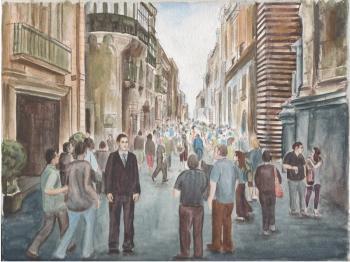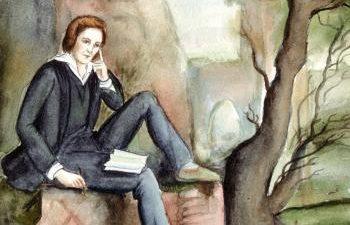
What is our response to death? Not in the abstract but in the horribly, humiliatingly particular? What is our reaction when we see a body broken into pieces, burned, or tossed into the ground, with apparently no trace of its former humanity, no trace of soul?
The answer, for some, is despair. Others turn away, urge themselves to forget, or fall into pious sentimentalities. We don’t want to disturb our tidy little lives with the brutal and brutalizing facts of decay and death. But perhaps another answer is possible.
This prince has long been kept by his father as a prisoner in a palace of earthly delights full of beautiful women, obedient servants, and a thousand distractions. Yet, curious of the world beyond, he ventures out of his delightful prison and sees terrible suffering.
He sees, at first, an old man. This man is “a wretch in rags, haggard and foul/ An old, old man, whose shriveled skin, sun-tanned/ Clung like a beast’s hide to his fleshless bones.” Arnold’s language pulls no punches. Its purple alliterations and banging monosyllables bring the man tottering out of the page to haunt our conscience.
The prince assumes the old man must have been born in this terrible condition—and is amazed to discover that his quavering, palsied appearance is merely the work of time. He realizes that he, too, will become as stooped, toothless, and frail.
Next, he sees a man convulsing in the dust, “caught by some deadly plague.” The victim lies, “writhing, with fiery purple blotches specked.” Again, the prince is told there is nothing to be done—and one day he may be struck down by such a silent killer. And, as if things couldn’t get any worse, the prince sees the worst sight of all: death itself.
This is where the extract begins, as the prince “raises his eyes” to a vista of mourning. This ordinary phrase captures the combination of fear and illumination that will transform him into quite another figure. The “wailing” people he sees “ungirt,” meaning naked, seem stripped of hope and dignity. They cry out to the god Rama, who is often depicted holding a bow and arrow indicating his readiness to destroy evils. But no one, not even Rama, can vanquish death. Here he could stand for any god or supernatural agency we turn to in moments of crisis, but who appears oblivious to our cries.
The mourners bear the funeral bier on which lies the corpse. The description of the body has a gloating quality that captures a sense of both tragedy and appalling comedy: “Whereon [he] lay, stark and stiff, feet foremost, lean/ Chapfallen, sightless, hollow-flanked, a-grin…” The cackling death’s head signals its victory over life. The grieving multitude turn the head to the four compass points, but there is no reply and no respite.
Finally they reach the stream, perhaps symbolic of the tide that carries our spirits away to stranger shores—perhaps a heaven, a rebirth, or nothing at all.
And then they burn the body, saying a last farewell. The creeping, licking, flickering fire appears almost demonic, a snake, or perhaps a hydra with many hissing heads, poisoning our dignity. When Arnold describes the “crackle of parched skin, and snap of joint,” we are uncomfortably reminded of the Sunday joint. Man as meat.
As the smoke thins and the ashes sink down, we see what lies within—nothing except for the dazzling whiteness of bones. Is this all we are? Do we laugh? Do we scream? Do we stay to linger or run back into the walled citadel of our illusions?
For Prince Siddhartha, the answer is clear. It is at this moment that he decides to desert his home and venture into the wilderness to try and find the answer to life’s riddles. And there, under a Bodhi tree, he attains enlightenment. He becomes the Buddha.
What can we conclude from this? Spiritual illumination, far from being quenched by the horrors of suffering and death, is lit the very moment we look life full in the face.





